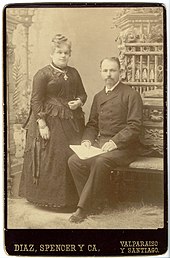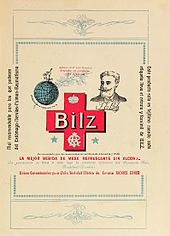Bilz y Pap
Bilz and Pap are the names of the two most popular and best-selling domestic carbonated and non-alcoholic sodas in Chile . Bilz y Pap is used as the combined marketing name of these two drinks.
The Bavarian Andrés (Andreas) Ebner Anzenhofer (1850–1905), who emigrated to Chile around 1870, brought an unauthorized imitation product of the Bilz-Brause , a red lemonade, onto the market with his Cervecería Ebner due to the international success of Friedrich Eduard Bilz 's naturopathy in Chile with a strawberry flavor called Bilz that was not based on the original recipe.
While the Lippe merchant and beverage specialist Franz Hartmann , who produced the Bilz-Brause in Germany, developed the new name Sinalco as early as 1905 because of the many imitators , Ebner stayed with the name Bilz . In the same year 1905 Ebner died of cancer and his Cervecería was continued by his son. In 1907 Ebner joined the later Chilean Compañía de Cervecerías Unidas (CCU), the largest Chilean bottler at the time, in 1916 his company was completely taken over and production continued.
Pap , originally called Papaya Rex Imitation , was launched in 1927, it has a papaya flavor . Bilz now has an artificially produced taste.
From 1970, the advertising for the two lemonades was combined, it culminates today in the popular Chilean marketing slogan of the "World of Bilz and Pap" ("El mundo de Bilz y Pap"), a fantasy world created by two extraterrestrial figures, the red one Bily Bilz and the yellow Maik Pap ( Bily y Maik ), is embodied.
The company, which also holds the bottling license for Pepsi in Chile, now also sells the diet varieties Bilz light and Pap light , as well as the third variety, Kem with pineapple flavor .
Web links
Individual evidence
- ↑ a b es: Bilz y Pap

